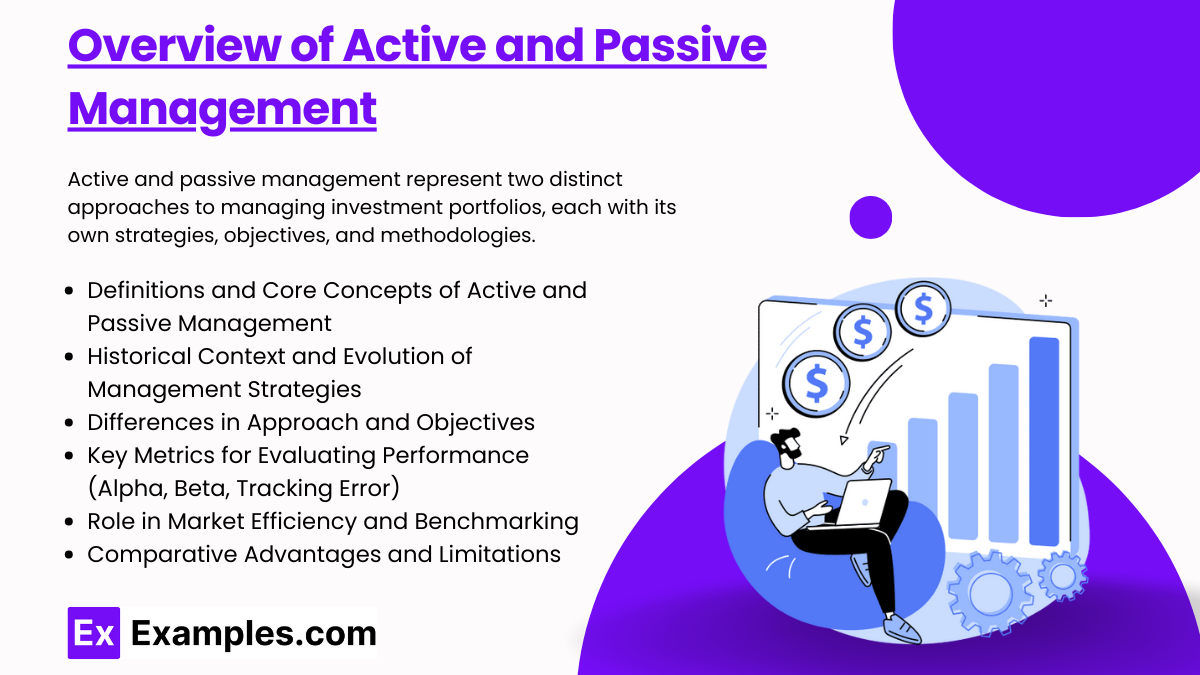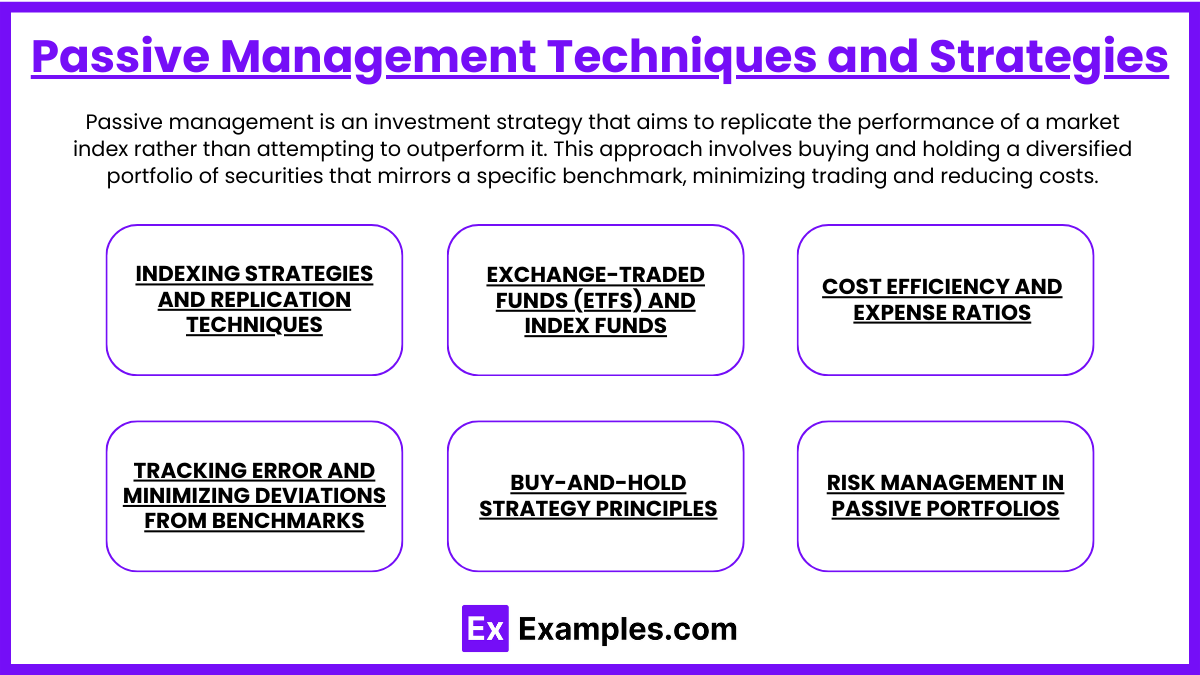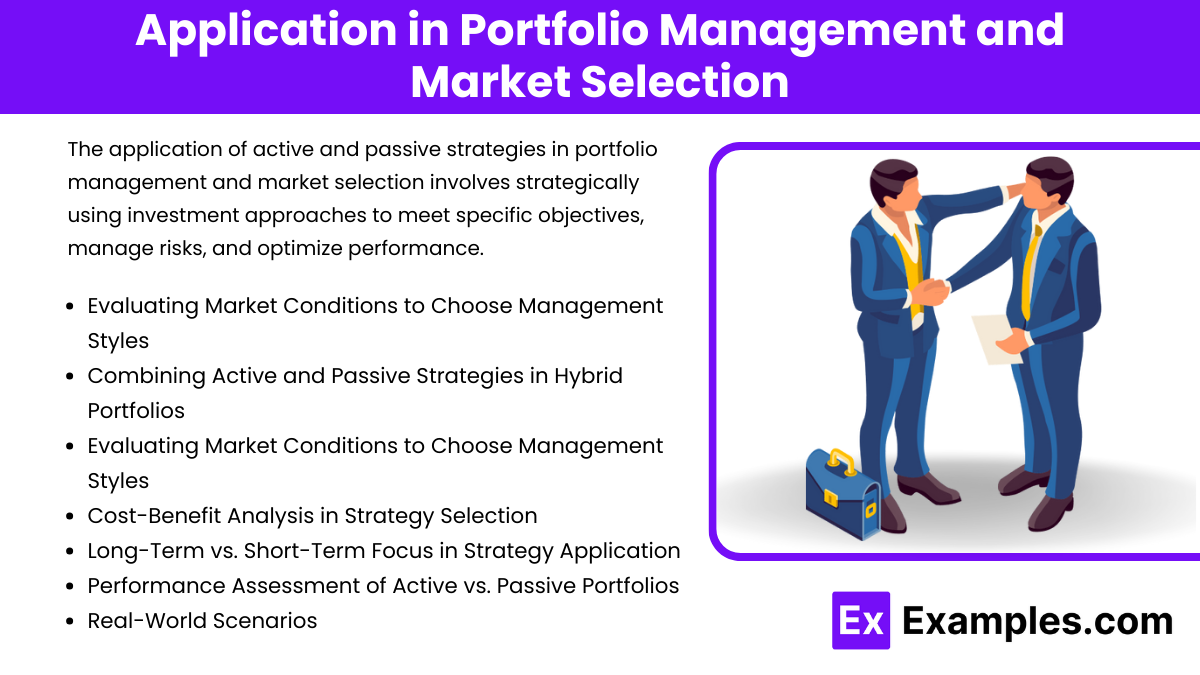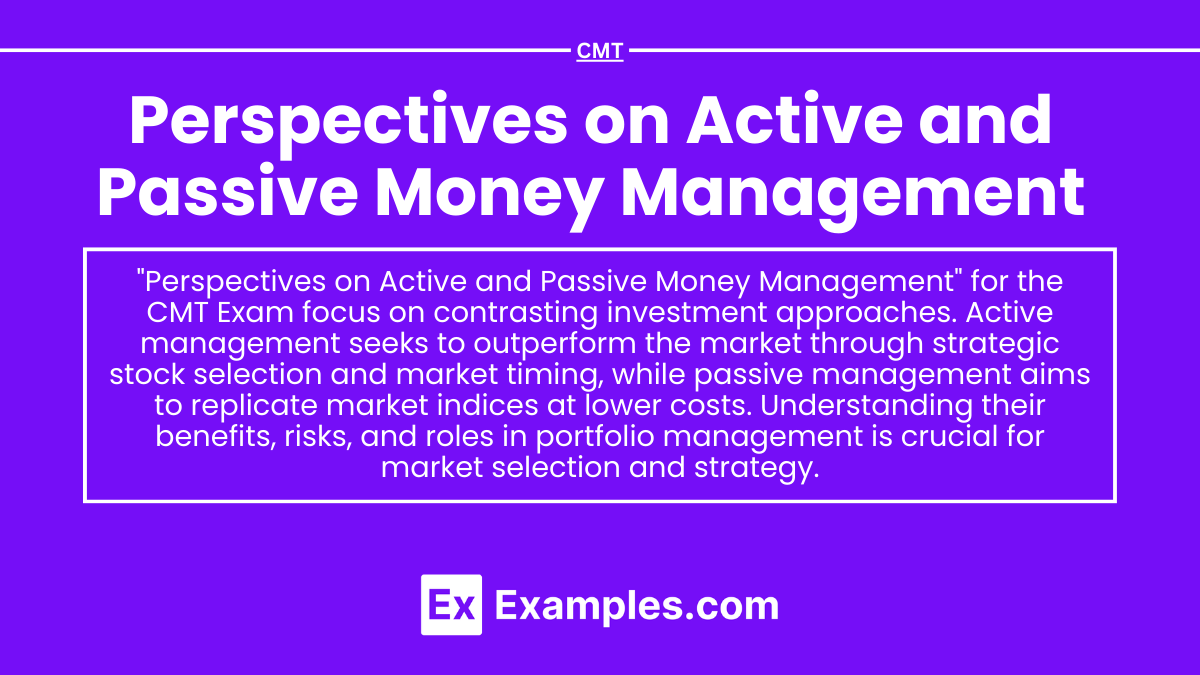Preparing for the CMT Exam requires a thorough understanding of “Perspectives on Active and Passive Money Management.” Mastery of these investment approaches includes analyzing market trends, asset allocation strategies, and performance metrics. This knowledge helps evaluate market efficiencies, optimize portfolio returns, and align investment strategies with market conditions, essential for success in financial analysis and management.
Learning Objective
In studying “Perspectives on Active and Passive Money Management” for the CMT Level 2 Exam, you should understand the key principles and strategies underlying both approaches. Analyze how active management uses market analysis, stock selection, and timing to outperform benchmarks, while passive management focuses on replicating index performance. Evaluate market efficiency theories and the cost-benefit trade-offs between active and passive strategies. Additionally, explore how these strategies fit within portfolio management, risk mitigation, and overall investment objectives. Apply this knowledge to interpret market scenarios, assess performance metrics, and optimize portfolio strategies based on market conditions and investment goals.
Overview of Active and Passive Management

Active and passive management represent two distinct approaches to managing investment portfolios, each with its own strategies, objectives, and methodologies. This overview explains the key aspects of both approaches, highlighting their roles in investment decision-making and market analysis:
- Definitions and Core Concepts of Active and Passive Management: Active management involves a hands-on approach where portfolio managers make specific investments based on market research, forecasts, and analysis with the goal of outperforming a benchmark index. Passive management, on the other hand, aims to replicate the performance of a benchmark index by holding a representative sample of the index’s components, without frequent buying or selling.
- Historical Context and Evolution of Management Strategies: Active management has traditionally been the dominant approach, with managers seeking to exploit market inefficiencies. However, passive management has grown significantly, driven by research supporting market efficiency and the cost-effectiveness of index-based strategies. The rise of exchange-traded funds (ETFs) and index funds has fueled this trend.
- Differences in Approach and Objectives: Active management seeks to achieve higher returns by actively selecting securities and timing market movements, while passive management focuses on matching the performance of a market index, minimizing costs, and reducing the need for active decision-making. Active strategies aim for “alpha” (excess returns over the market), while passive strategies prioritize consistent market returns.
- Key Metrics for Evaluating Performance (Alpha, Beta, Tracking Error): Active managers are often evaluated based on their ability to generate alpha while managing risk (beta). Passive strategies are assessed by their tracking error, which measures the deviation of the portfolio’s performance from the benchmark index. Lower tracking error indicates greater success in replicating index performance.
- Role in Market Efficiency and Benchmarking: Passive management relies on the Efficient Market Hypothesis (EMH), which suggests that markets reflect all available information, making it difficult for active managers to consistently outperform. Benchmarking is a key aspect of both strategies, with active managers seeking to outperform benchmarks and passive managers aiming to match them.
- Comparative Advantages and Limitations: Active management offers the potential for high returns but comes with higher costs and risks due to frequent trading and the need for specialized expertise. Passive management offers cost efficiency, lower fees, and transparency, but may underperform during market downturns or fail to capitalize on market inefficiencies.
Active Management Techniques and Strategies

Active management involves a hands-on approach to investing, where portfolio managers actively make decisions to buy, sell, or hold various securities with the objective of outperforming a specific market index or benchmark. This approach relies on extensive research, market analysis, and strategic adjustments to capitalize on market inefficiencies. Here’s a detailed explanation of key techniques and strategies used in active management:
- Stock Selection and Fundamental Analysis: Active managers conduct in-depth research and analysis of individual companies to identify undervalued or overvalued securities. This involves examining financial statements, assessing a company’s growth potential, analyzing industry trends, and evaluating economic factors. The goal is to make informed decisions about which stocks to include or exclude in a portfolio.
- Technical Analysis and Market Timing: Active managers often use technical analysis to analyze price trends, trading volumes, and market patterns. This helps in identifying potential entry and exit points for trades. Market timing involves predicting market movements to buy low and sell high, with the aim of maximizing returns and minimizing losses.
- Sector Rotation and Asset Allocation: Active managers may adjust the portfolio’s allocation across different sectors or asset classes based on their analysis of economic cycles and market conditions. This strategy seeks to capitalize on sectors expected to perform well while reducing exposure to those likely to underperform. Sector rotation is often used to align investments with macroeconomic trends, interest rate changes, and industry developments.
- Risk Management Techniques in Active Management: Active managers use various risk management techniques to protect their portfolios from potential losses. This may include setting stop-loss orders, diversifying across different asset classes, using derivatives for hedging purposes, and regularly rebalancing the portfolio to maintain an optimal risk-reward balance.
- Evaluating Active Performance Against Benchmarks: Active managers aim to outperform a specific benchmark index. Performance evaluation involves comparing the portfolio’s returns with the benchmark’s returns over a specified period. Metrics such as alpha (excess return over the benchmark) and beta (measure of risk relative to the benchmark) are used to assess the manager’s effectiveness in generating superior returns.
- Costs and Fees Associated with Active Management: Active management tends to have higher fees due to the costs of research, frequent trading, and management expertise. While these fees can erode returns, the expectation is that active managers will deliver value through superior performance, though consistent outperformance remains challenging due to market efficiency.
Passive Management Techniques and Strategies

Passive management is an investment strategy that aims to replicate the performance of a market index rather than attempting to outperform it. This approach involves buying and holding a diversified portfolio of securities that mirrors a specific benchmark, minimizing trading and reducing costs. Here is a detailed explanation of key techniques and strategies used in passive management:
- Indexing Strategies and Replication Techniques: The cornerstone of passive management is index investing, where a portfolio is structured to mirror a specific market index, such as the S&P 500 or a bond index. There are two primary replication methods: full replication, where all the index’s constituents are held in the same proportions, and sampling, where a representative subset of the index’s securities is held to achieve similar returns.
- Exchange-Traded Funds (ETFs) and Index Funds: ETFs and index funds are popular vehicles for passive investing. They provide investors with exposure to a broad market or sector while maintaining low costs. ETFs trade on stock exchanges, offering liquidity and real-time pricing, while index funds are typically mutual funds that track a specific index.
- Cost Efficiency and Expense Ratios: One of the key advantages of passive management is cost efficiency. Passive funds typically have lower expense ratios compared to actively managed funds due to minimal trading activity and fewer research expenses. This cost savings can significantly impact long-term returns, making passive strategies attractive to cost-conscious investors.
- Tracking Error and Minimizing Deviations from Benchmarks: Tracking error measures the difference in performance between a passive fund and its benchmark index. Effective passive management aims to minimize tracking error to ensure that the portfolio closely mirrors the index’s returns. Factors such as transaction costs, changes in the index, and cash flows can impact tracking error, and managers use various techniques to reduce it.
- Buy-and-Hold Strategy Principles: Passive management generally follows a buy-and-hold approach, where securities are purchased and held over the long term. This strategy avoids frequent trading and attempts to capture the overall market’s growth over time. It is based on the belief that, in the long run, markets tend to rise and provide positive returns.
- Risk Management in Passive Portfolios: Although passive strategies are less hands-on than active management, they still involve risk management considerations. Diversification is a key technique used to spread risk across a broad array of securities, reducing the impact of poor performance by individual holdings. Passive investors must also monitor changes to the index being tracked and adjust the portfolio accordingly.
Application in Portfolio Management and Market Selection

The application of active and passive strategies in portfolio management and market selection involves strategically using investment approaches to meet specific objectives, manage risks, and optimize performance. This application requires a deep understanding of market conditions, investor goals, and the relative advantages of each strategy. Here’s how active and passive strategies are applied within portfolio management and market selection:
- Combining Active and Passive Strategies in Hybrid Portfolios: Many investors adopt a hybrid approach by combining active and passive strategies within a single portfolio. Passive investments, such as index funds and ETFs, provide broad market exposure and cost efficiency, while active investments seek to capitalize on market inefficiencies and generate excess returns. This combination aims to balance cost, risk, and potential return.
- Evaluating Market Conditions to Choose Management Styles: Market conditions often influence whether an investor favors active or passive management. For example, in highly efficient markets, passive strategies may be more effective since outperforming the market is challenging. Conversely, active management may be preferred in less efficient markets, where skilled managers can exploit mispricings.
- Cost-Benefit Analysis in Strategy Selection: Cost is a critical factor in choosing between active and passive management. Active management typically involves higher fees due to frequent trading, research costs, and management expertise, which may reduce net returns. Passive strategies, with their lower costs and expense ratios, offer an attractive alternative for investors focused on minimizing costs and maximizing net returns.
- Long-Term vs. Short-Term Focus in Strategy Application: Passive strategies are generally aligned with a long-term investment horizon, capturing market trends over extended periods. Active strategies may focus on both short-term and long-term gains, taking advantage of market volatility, trends, and opportunities. Selecting the appropriate strategy depends on an investor’s time horizon, goals, and risk tolerance.
- Performance Assessment of Active vs. Passive Portfolios: Evaluating the success of a portfolio often involves comparing the performance of active and passive components. Active managers are assessed based on their ability to generate alpha (excess returns) relative to a benchmark, while passive components are measured by how closely they track the index, with lower tracking errors being favorable.
- Real-World Scenarios and Case Studies in Strategy Implementation: Applying active and passive strategies requires practical understanding through case studies and historical scenarios. For example, an investor might analyze past market downturns to see how passive portfolios provided stability, while active managers either outperformed or underperformed due to market volatility and strategy choices.
Examples
Example 1: Active Management in Volatile Markets
An active portfolio manager analyzes market trends and economic data to identify undervalued stocks during a period of heightened market volatility. By selectively buying and selling stocks, the manager aims to capitalize on short-term price fluctuations, seeking to outperform the market index through in-depth analysis and strategic timing.
Example 2: Cost Efficiency in Passive Management
A passive investor allocates their portfolio to low-cost index funds that replicate the S&P 500. By minimizing fees and reducing turnover, the investor captures the broad market’s performance with minimal cost, adhering to a long-term buy-and-hold strategy and maximizing net returns over time.
Example 3: Evaluating Market Efficiency
An investor studies market efficiency theories to decide between active and passive management. Believing that most markets are efficient, they favor a passive approach to capture market returns without incurring higher active management costs. Conversely, they might use active management selectively in less efficient or niche markets.
Example 4: Combining Active and Passive Strategies
A portfolio manager constructs a hybrid portfolio by combining passive index funds for core market exposure and active funds for sectors where they believe they can generate excess returns. This approach balances cost efficiency with the potential for outperformance, adapting to varying market conditions.
Example 5: Tracking Error and Performance Measurement
A passive fund manager monitors the portfolio’s tracking error relative to the benchmark index. By minimizing deviations from the index’s performance, the manager ensures that the fund delivers consistent market returns, aligning closely with the chosen benchmark and maintaining investor confidence in passive management.
Practice Questions
Question 1:
Which of the following best describes a key advantage of passive money management?
A) The ability to quickly react to market changes
B) Lower fees and expense ratios compared to active management
C) Higher potential to outperform the market consistently
D) Greater flexibility in selecting individual securities
Answer: B) Lower fees and expense ratios compared to active management
Explanation:
Passive management focuses on replicating the performance of a market index, resulting in lower costs due to minimal trading, reduced research expenses, and lower management fees. This cost efficiency is a significant advantage over active management, which typically incurs higher expenses due to more frequent trading and market research. Options A, C, and D are characteristics more closely associated with active management.
Question 2:
An active money manager is most likely to rely on which of the following strategies?
A) Replicating the performance of an index fund
B) Using a buy-and-hold strategy to minimize trading costs
C) Conducting in-depth market analysis to identify mispriced assets
D) Holding the same assets over a fixed period regardless of market changes
Answer: C) Conducting in-depth market analysis to identify mispriced assets
Explanation:
Active managers aim to outperform the market by conducting detailed research and analysis to identify undervalued or overvalued assets. They actively make buy, sell, or hold decisions based on their analysis. In contrast, passive management focuses on replicating market indices (A), using a buy-and-hold approach (B), and maintaining a fixed asset allocation (D).
Question 3:
Which of the following best describes the primary goal of passive management?
A) To generate alpha through frequent trading and market timing
B) To minimize tracking error while replicating the performance of an index
C) To use leverage and derivatives for speculative gains
D) To outpace market benchmarks through superior stock selection
Answer: B) To minimize tracking error while replicating the performance of an index
Explanation:
The main objective of passive management is to closely track the performance of a chosen index, minimizing the difference (or tracking error) between the portfolio’s returns and the index’s returns. Unlike active strategies (A, C, D), passive management does not seek to outperform the market but to match its performance as closely as possible, with minimal cost.


